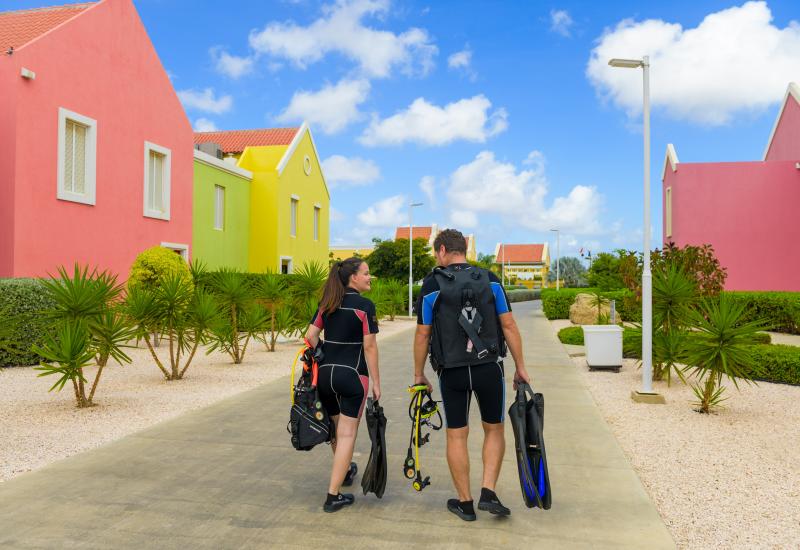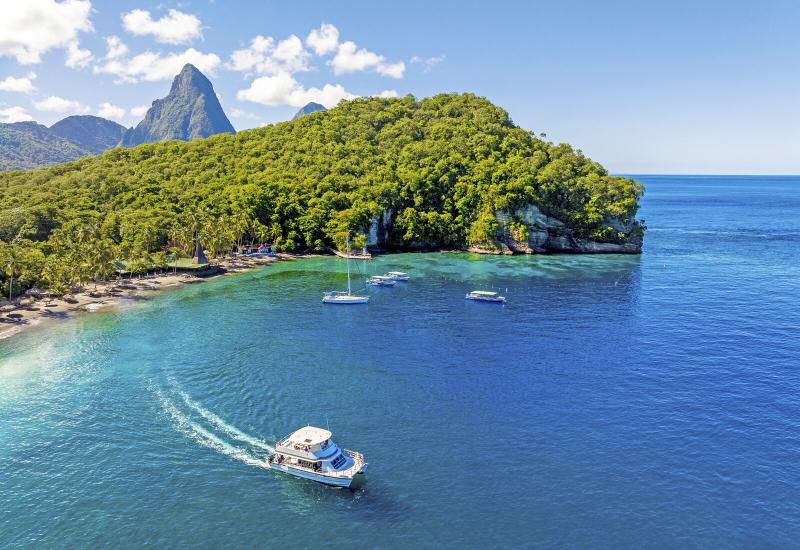Adventure Guide Bahamas

August 2007
By Stephen Frink
Once you get your head around the fact that the Bahamas cover 100,000 square miles of the planet and that only 5,382 square miles of that is dry land, you quickly realize that the greatest part of this island nation lies beneath the waves. Accept it: There's no way to see it all.
To help you find exactly the underwater portion of the Bahamas that suits your diving desires, we've put together an adventure guide to the best the islands have to offer. Whether you're looking for pulse-pounding shark action, bottomless blue holes, effortless drift diving or irresistible wrecks, it's just a matter of choosing an island and naming your adventure. You can save the other 99,000-plus square miles for your next trip.
The Abacos
From north to south, the Abacos stretch more than 120 miles, from Walker's Cay to Hole in the Wall. Sheltered harbors make this region popular for yachtsmen, and lately many North Americans have discovered this is a great place to have a holiday home. Still, the pace is laid-back and the scenery quaint. Don't expect high-rises or shopping malls here, because the Abacos are all about a more leisurely way of life. There are several islands where dive adventure is easily arranged, including Marsh Harbour, Great Abaco and Green Turtle Cay.
Wrecks The wreck of the San Jacinto is a great dive off Green Turtle Cay. Built in 1847 and probably run aground while performing blockade duty during the Civil War, she now lies scattered in 40 feet of water. Her boiler, propeller shaft and bits of superstructure remain as refuge to clouds of blue-striped grunts and friendly green morays.
Sharks Most of the diving off Great Abaco is in the Fowl Cays Undersea Preserve. The protected marine life here predictably attracts predators, and a shark feed now brings a dozen or more Caribbean reef sharks to a frozen conglomerate of fish heads.
Caverns One of the unique aspects of Abacos diving is the intricate cavern systems. Off Marsh Harbour, a site called the Catacomb features shimmering shafts of light that percolate through the ceiling of the cavern. At Coral Caverns off Green Turtle Cay, look for thick concentrations of glass minnows hiding beneath ledges and being stalked by tarpon, jacks and grouper.
Andros
Andros is the largest of the islands of the Bahamas, in size if not population. It is 104 miles long by 40 miles wide--2,300 square miles--and features lots of fresh water, beaches, mangrove trees and vast pine forests. You'd think that would have been a magical combination for development, but the island remains rather sleepy even today. Of course, that's the great appeal of the island for many visitors. Andros remains a quiet getaway, and offers some of the best bonefishing in the Bahamas to boot. For divers, Andros offers plenty of thrills including spectacular walls on the Tongue of the Ocean and pulse-pounding shark dives.
Wrecks The best wreck dive I ever did on Andros was the Potomac in only about 20 feet of water. While storms have scoured her of much coral or sponge decoration in recent years, this steamship is still a fascinating look at maritime history. Located near the channel leading into Coconut Bay, portions of the Potomac jut out of the water at low tide. On the other side of the island, nearer Small Hope Bay, the work barge Marion rests in 70 feet of water and is patrolled by friendly groupers that greet divers on descent.
Sharks Caribbean reef sharks are lured into a coral amphitheater at the Shark Emporium with a frozen chumsicle made of fish heads and entrails. A melee erupts as the sharks compete for morsels, completely indifferent to the divers kneeling on the sand floor beneath.
Blue Holes Andros is riddled with both terrestrial and oceanic blue holes, a complement to the many cavern dives found here as well. Stargate, Guardian Blue Hole, Big Blue Hole, Little Frenchman and Uncle Charlie's Blue Hole are among the most popular blue holes dived in and off Andros.
Bimini
Though the Biminis are the closest Bahamian islands to the mainland United States, the atmosphere here is worlds away. I visited recently for the first time in years. In the old days, I would have flown into Bimini on a Chalk's seaplane, and sat down to have a beer at the Compleat Angler. But Chalk's quit operating seaplanes a few years ago, and the Compleat Angler burned to the ground. There's still plenty of airlift into the South Bimini airstrip, however, and there are still plenty of places to sip a Kalik.
Wrecks The Sapona is a standout wreck, quite literally--most of the ship is actually above the water. Her hull is riddled with holes from aircraft target practice bullets and time. Massive schools of grunts are found inside the stern section, and the wide-angle photo opportunity of the giant propeller against the afternoon sun is reason enough to make the trip.
Sharks Bull Run is a popular shark dive south of the Biminis, a site frequented by the Blackbeard's and Nekton live-aboard boats, as well as dive and pleasure boats from Bimini. The sharks get pretty used to associating divers with food and typically swim near, whether there is bait in the water or not. Ultra-clear water and high-profile coral heads make for a nice complement to the shark action.
Dolphins It's a 10-mile ride from Bimini to the gathering grounds of wild spotted dolphins, and there is no protection from the prevailing wind. So plan a trip when winds are favorable--usually mid-May through October--to enjoy this must-do experience. No food is offered, but dive operators Bill and Nowdla Keefe still enjoy a 90 percent success rate in finding these amazing animals.
Walls The walls off Bimini can be deep, and that's the way some nitrogen junkies like 'em. The site known as the Nodules starts at just 70 feet, but the best stuff, the overhangs, gorgonians and largest elephant ear sponges, are at 120 feet, so be prepared to dive deep.
Eleuthera
Located some 60 miles east of Nassau, Eleuthera and Harbour Island feature impossibly scenic pink sand beaches. Resorts here tend to be small and intimate, and there are some pretty nice reefs accessible from shore, but the best dives are found after a giant stride from a local operator's dive boat.
Wrecks The Devil's Backbone off nearby Spanish Wells has claimed many ships over the years, and at least one train. The train was aboard a barge that sank during the Civil War and can be dived in 30 feet of water. Other wrecks include a 200-foot freighter from 1919 and the wreck of a 265-foot freighter that sank in 1971.
Drift Dives Eleuthera is home to Current Cut, the most famous drift dive in the Bahamas. Divers often make multiple runs along the Cut, drifting at high velocity past large coral heads and colorful filter feeders, and the dive boat picks them up as they exit the tidal channel. I've heard the currents here run from three to 10 knots, and while I know it was really cooking the few times I've dived it, I doubt it was close to 10 knots. Still, it was fast enough that I definitely wasn't going to stop to take a photo.
Exuma
The Exumas comprise 365 cays spread over 120 miles, with amenities running the gamut from an incredible Four Seasons resort on Great Exuma to the more basic yachting resorts found around Georgetown and Staniel Cay. These islands are the very definition of "tropical paradise" with turquoise waters lapping miles of white sand beaches and secluded anchorages. Many divers see the Exumas by hopping one of the live-aboard boats that regularly cruise the area, and a memorable trip I made revealed a world of wonder within the Exuma Cays Land and Sea National Park.
Sharks In just 40 feet of water off Amberjack Reef, live-aboard boats devise their own methods of feeding the resident sharks. The crew of Aqua Cat tethers a frozen chumsicle in midwater while dozens of Caribbean reef sharks dash in to frantically devour the bait. After the feed, photo ops are especially good because the sharks hang around and the water becomes more clear and the activity less frenzied.
Walls The Exumas offer an abundance of wall dives, some at named sites and others wherever the deep blue of the precipice meets the electric cyan of the shallows. One of my more memorable wall dives was at Dog Rock Wall, where a thousand or so Atlantic spadefish obscured the path to the drop-off and glass minnows choked the swim-throughs leading to the wall, all of which distracted me from seeing the massive black coral trees that decorated the wall face.
Drift Dives As good as Eleuthera's Current Cut is, I have to say I prefer the Wax Cay Cut for a high-velocity drift dive, just because the corals and sea fans are so vibrant here. Of course, the huge angelfish will tempt you to try to stop to take a picture, but when the current is right, and the ride is cookin', it is futile to do anything other than go with the flow.
Grand Bahama
Grand Bahama Island, long one of the hubs of Bahamian tourism, is currently being rediscovered by resort development. Commerce and tourism has always centered around Freeport, the second-largest city in the Bahamas. But in the past few years, West End, Grand Bahama, is getting significant attention as well. With waterfront real estate in Florida becoming exorbitantly expensive, and Grand Bahama land a relative bargain, large golf and boating resorts are springing up in areas that were previously desolate. Still, Freeport remains the home of most of the dive activity, anchored by a wealth of resort properties in the Port Lucaya area.
Sharks Shark diving is something UNEXSO, Xanadu Undersea Adventures and the other dive operations in Freeport have learned to do very well indeed. At Shark Junction, a chainmail-suited diver brings a dozen or so large Caribbean reef sharks in for an up-close-and-personal interaction with divers.
Dolphins The Dolphin Experience at UNEXSO is one of the world's best. Sixteen bottlenose dolphins are maintained in a spacious enclosure at Sanctuary Bay, 10 of which have been born in captivity. As long as you're able to keep them entertained (and the bait holds out), the dolphins are game to play. The famed White Sand Ridge north of West End, Grand Bahama, is one of the world's great spots for wild dolphin encounters. Here bottlenose dolphins are commonly seen rooting around in the shallow sand bank for crustaceans, and a resident pod of spotted dolphins is quite accessible.
Caverns and Blue Holes The expansive Lucayan cavern system honeycombs Grand Bahama and offers several points of access at both inland and oceanic blue holes. The most popular is Ben's Cave. Part of the 40-acre Lucayan National Park and located about a half-hour outside of Freeport, Ben's Cave features an easy hike from a parking lot and down a spiral staircase into a large cavern lavishly decorated with stalactites and stalagmites.
Long Island
For the past 40 years, the dive scene on Long Island has been centered around Stella Maris Resort Club and Marina. You can go down to Cape Santa Maria to see one of the most beautiful stretches of beach to be found anywhere in the Bahamas. And you can hike along the massive boulders decorating the rugged southern tip of the island. But otherwise, there's not much reason to go beyond Stella Maris to experience the best of Long Island.
Wrecks Stella Maris has sunk several boats as dive attractions over the years and my favorite is the 110-foot freighter Comberbach. The ship's propeller is cloaked in a brilliant crimson encrusting sponge that makes for stunning wide-angle images.
Sharks Shark Reef is located in just 30 feet of water on the lee side of the island. Divers kneel in the sand in front of high-profile coral heads, and the divemaster brings down a bait box. Controlled pandemonium ensues while a dozen or so Caribbean reef sharks tear into the proffered bait.
Walls The walls of nearby Conception Island are among the best in the Bahamas, starting in just 45 feet of water. This is one of the rare places where 200-foot visibility is not only possible, but is the norm.
New Providence
New Providence is best known as home to Nassau, the capital city of the Bahamas, and for its wildly popular resort hotel, Atlantis. The island's long maritime heritage continues today: Where pirate ships once docked, cruise ships now moor. And while golf, shopping and other tourist activities are popular, most of the pleasures here remain tied to the underwater world. The best of the diving can be found away from Nassau, along the southwest end of the island.
Wrecks On the southwest side of the island are remnants of ships sunk as movie props for the James Bond thrillers Never Say Never Again and Thunderball. The photogenic Willaurie is a popular dive, as is a multi-wreck site called Steel Forest, but the most popular wreck is the Ray of Hope, a 200-foot freighter that is the site of frequent shark feeds.
Sharks Caribbean reef sharks are plentiful thanks to the nutrients washing off the Great Bahama Bank and the deep oceanic trench known as the Tongue of the Ocean. Clad in chainmail suits and helmets, the staff at Stuart Cove's Dive Bahamas use crates of bait to attract sharks within inches of visiting divers.
Walls The Tongue of the Ocean offers precipitous walls dotted with giant purple tube sponges. One of the most popular ways to tour these sites is "wall-flying"--cruising the drop-offs with the help of a diver propulsion vehicle.
San Salvador
San Salvador may be best known as the purported site of Christopher Columbus's first landfall in the New World, but for a short while in the 1980s, the island was known for being the epicenter of recreational diving. This is when Skin Diver publisher Paul Tzimoulis ran photo classes here, and a lone dolphin named Sandy decided to take up residence for no apparent reason other than to swim with visiting divers. Those days are long gone, but San Salvador remains a significant dive destination, blessed with some of the clearest water I've ever seen in an ocean anywhere, amazing stretches of pristine white sand beach dotting the shoreline, and walls that start in 40 feet of water and boast rich corals, huge sponges and seasonal sightings of hammerheads.
Wrecks The Frascate was a 261-foot steamship, run aground under hurricane-force winds and now scattered in just 20 feet of water. The highlights are the massive boilers, with orifices large enough to swallow a diver or two.
Sharks There are no guarantees, but seasonal sightings of great hammerheads along the island's southwest end are possible.
Walls While the shallow reef is nice off San Sal, the walls are the big draw. The fact that they are vertical, begin in only 40 feet of water, and are washed by water with 100- to 150-foot clarity is a hard combination to beat. One standout site is Great Cut, a double drop where a huge section of the wall split away millennia ago. Once you drop into the cut, look for a swim-through tunnel at about 85 feet.
Bahamas Advertising Directory
Aqua Cat Cruises
888-327-9600
www.aquacatcruises.com
Coral Caverns Dive Resort
800-327-8150
www.coralcavernsresort.com
Explorer Ventures Live-Aboard Diving
800-322-3577
www.explorerventures.com
Nekton Diving Cruises
800-UW-WORLD
www.NektonCruises.com
Stella Maris Resort Club
800-426-0466
www.stellamarisresort.com
Stuart Cove's Dive Bahamas
800-879-9832
www.stuartcove.com
UNEXSO
800-992-DIVE
www.unexso.com
InDepth
Weather: In winter and early spring, temperatures range from 60 to 75 degrees, while summer temps are in the low to mid-80s.
Average Water Temp: Summer water temps peak in the high 80s; winter temps drop to the 70s.
Average Visibility: 80 to 100 feet.
Travel Savvy: A passport is required. Nonstop flight time from Miami (MIA) to Nassau/Paradise Island (NAS) and Freeport, Grand Bahama (FPO) is about 35 minutes. Nonstop flights are also available from other U.S. gateways, including Charlotte (CLT) and Philadelphia (PHL). Inter-island flights are readily available. Departure tax for Grand Bahama is $18; $15 for New Providence and the Out Islands.
Destination Links: www.scubadiving.com/bahamas, www.bahamas.com, www.bahama-out-islands.com, www.bahamasdiving.com.
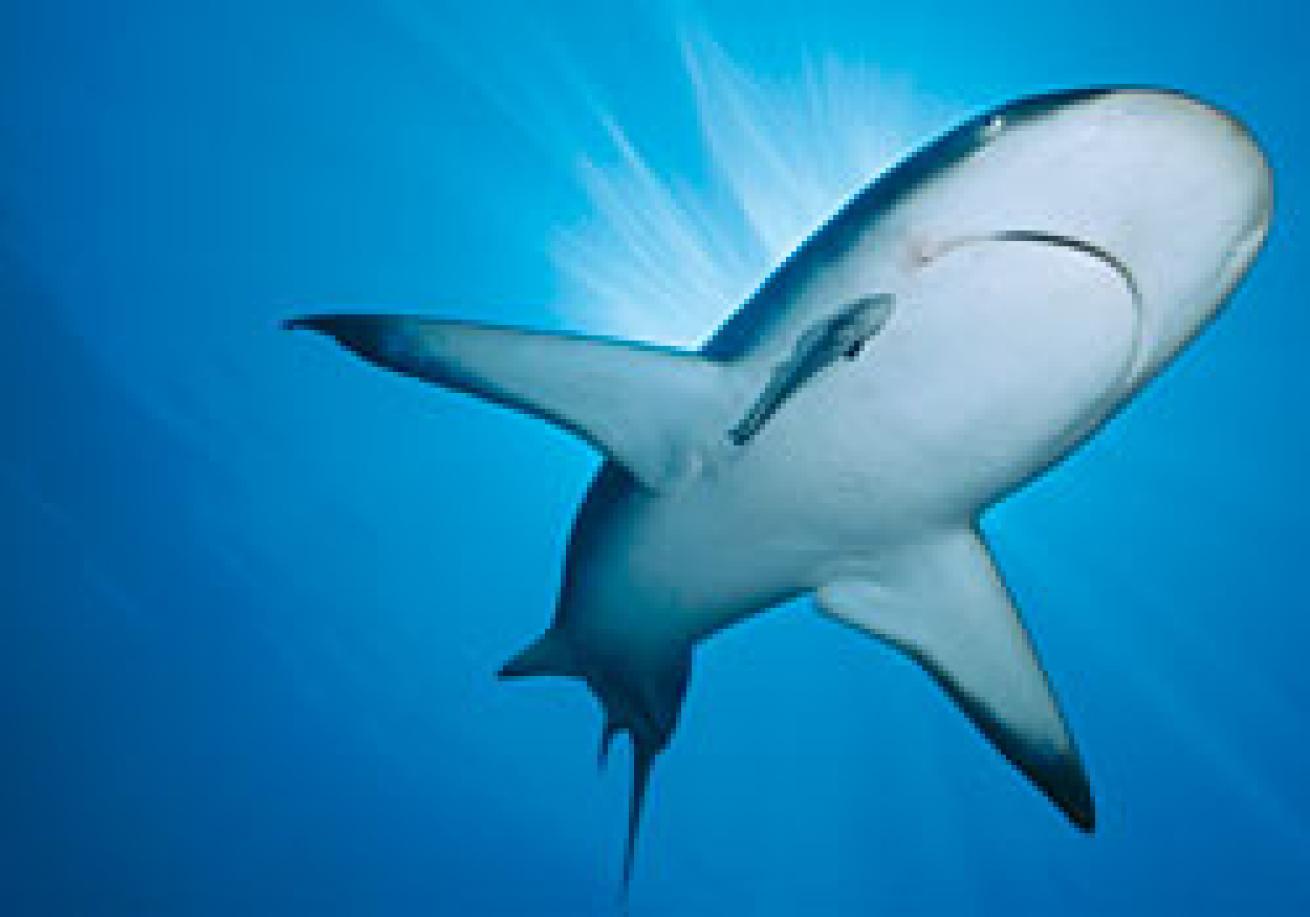
Once you get your head around the fact that the Bahamas cover 100,000 square miles of the planet and that only 5,382 square miles of that is dry land, you quickly realize that the greatest part of this island nation lies beneath the waves. Accept it: There's no way to see it all.
To help you find exactly the underwater portion of the Bahamas that suits your diving desires, we've put together an adventure guide to the best the islands have to offer. Whether you're looking for pulse-pounding shark action, bottomless blue holes, effortless drift diving or irresistible wrecks, it's just a matter of choosing an island and naming your adventure. You can save the other 99,000-plus square miles for your next trip.
The Abacos
From north to south, the Abacos stretch more than 120 miles, from Walker's Cay to Hole in the Wall. Sheltered harbors make this region popular for yachtsmen, and lately many North Americans have discovered this is a great place to have a holiday home. Still, the pace is laid-back and the scenery quaint. Don't expect high-rises or shopping malls here, because the Abacos are all about a more leisurely way of life. There are several islands where dive adventure is easily arranged, including Marsh Harbour, Great Abaco and Green Turtle Cay.
Wrecks The wreck of the San Jacinto is a great dive off Green Turtle Cay. Built in 1847 and probably run aground while performing blockade duty during the Civil War, she now lies scattered in 40 feet of water. Her boiler, propeller shaft and bits of superstructure remain as refuge to clouds of blue-striped grunts and friendly green morays.
Sharks Most of the diving off Great Abaco is in the Fowl Cays Undersea Preserve. The protected marine life here predictably attracts predators, and a shark feed now brings a dozen or more Caribbean reef sharks to a frozen conglomerate of fish heads.
Caverns One of the unique aspects of Abacos diving is the intricate cavern systems. Off Marsh Harbour, a site called the Catacomb features shimmering shafts of light that percolate through the ceiling of the cavern. At Coral Caverns off Green Turtle Cay, look for thick concentrations of glass minnows hiding beneath ledges and being stalked by tarpon, jacks and grouper.
Andros
Andros is the largest of the islands of the Bahamas, in size if not population. It is 104 miles long by 40 miles wide--2,300 square miles--and features lots of fresh water, beaches, mangrove trees and vast pine forests. You'd think that would have been a magical combination for development, but the island remains rather sleepy even today. Of course, that's the great appeal of the island for many visitors. Andros remains a quiet getaway, and offers some of the best bonefishing in the Bahamas to boot. For divers, Andros offers plenty of thrills including spectacular walls on the Tongue of the Ocean and pulse-pounding shark dives.
Wrecks The best wreck dive I ever did on Andros was the Potomac in only about 20 feet of water. While storms have scoured her of much coral or sponge decoration in recent years, this steamship is still a fascinating look at maritime history. Located near the channel leading into Coconut Bay, portions of the Potomac jut out of the water at low tide. On the other side of the island, nearer Small Hope Bay, the work barge Marion rests in 70 feet of water and is patrolled by friendly groupers that greet divers on descent.
Sharks Caribbean reef sharks are lured into a coral amphitheater at the Shark Emporium with a frozen chumsicle made of fish heads and entrails. A melee erupts as the sharks compete for morsels, completely indifferent to the divers kneeling on the sand floor beneath.
Blue Holes Andros is riddled with both terrestrial and oceanic blue holes, a complement to the many cavern dives found here as well. Stargate, Guardian Blue Hole, Big Blue Hole, Little Frenchman and Uncle Charlie's Blue Hole are among the most popular blue holes dived in and off Andros.
Bimini
Though the Biminis are the closest Bahamian islands to the mainland United States, the atmosphere here is worlds away. I visited recently for the first time in years. In the old days, I would have flown into Bimini on a Chalk's seaplane, and sat down to have a beer at the Compleat Angler. But Chalk's quit operating seaplanes a few years ago, and the Compleat Angler burned to the ground. There's still plenty of airlift into the South Bimini airstrip, however, and there are still plenty of places to sip a Kalik.
Wrecks The Sapona is a standout wreck, quite literally--most of the ship is actually above the water. Her hull is riddled with holes from aircraft target practice bullets and time. Massive schools of grunts are found inside the stern section, and the wide-angle photo opportunity of the giant propeller against the afternoon sun is reason enough to make the trip.
Sharks Bull Run is a popular shark dive south of the Biminis, a site frequented by the Blackbeard's and Nekton live-aboard boats, as well as dive and pleasure boats from Bimini. The sharks get pretty used to associating divers with food and typically swim near, whether there is bait in the water or not. Ultra-clear water and high-profile coral heads make for a nice complement to the shark action.
Dolphins It's a 10-mile ride from Bimini to the gathering grounds of wild spotted dolphins, and there is no protection from the prevailing wind. So plan a trip when winds are favorable--usually mid-May through October--to enjoy this must-do experience. No food is offered, but dive operators Bill and Nowdla Keefe still enjoy a 90 percent success rate in finding these amazing animals.
Walls The walls off Bimini can be deep, and that's the way some nitrogen junkies like 'em. The site known as the Nodules starts at just 70 feet, but the best stuff, the overhangs, gorgonians and largest elephant ear sponges, are at 120 feet, so be prepared to dive deep.
Eleuthera
Located some 60 miles east of Nassau, Eleuthera and Harbour Island feature impossibly scenic pink sand beaches. Resorts here tend to be small and intimate, and there are some pretty nice reefs accessible from shore, but the best dives are found after a giant stride from a local operator's dive boat.
Wrecks The Devil's Backbone off nearby Spanish Wells has claimed many ships over the years, and at least one train. The train was aboard a barge that sank during the Civil War and can be dived in 30 feet of water. Other wrecks include a 200-foot freighter from 1919 and the wreck of a 265-foot freighter that sank in 1971.
Drift Dives Eleuthera is home to Current Cut, the most famous drift dive in the Bahamas. Divers often make multiple runs along the Cut, drifting at high velocity past large coral heads and colorful filter feeders, and the dive boat picks them up as they exit the tidal channel. I've heard the currents here run from three to 10 knots, and while I know it was really cooking the few times I've dived it, I doubt it was close to 10 knots. Still, it was fast enough that I definitely wasn't going to stop to take a photo.
Exuma
The Exumas comprise 365 cays spread over 120 miles, with amenities running the gamut from an incredible Four Seasons resort on Great Exuma to the more basic yachting resorts found around Georgetown and Staniel Cay. These islands are the very definition of "tropical paradise" with turquoise waters lapping miles of white sand beaches and secluded anchorages. Many divers see the Exumas by hopping one of the live-aboard boats that regularly cruise the area, and a memorable trip I made revealed a world of wonder within the Exuma Cays Land and Sea National Park.
Sharks In just 40 feet of water off Amberjack Reef, live-aboard boats devise their own methods of feeding the resident sharks. The crew of Aqua Cat tethers a frozen chumsicle in midwater while dozens of Caribbean reef sharks dash in to frantically devour the bait. After the feed, photo ops are especially good because the sharks hang around and the water becomes more clear and the activity less frenzied.
Walls The Exumas offer an abundance of wall dives, some at named sites and others wherever the deep blue of the precipice meets the electric cyan of the shallows. One of my more memorable wall dives was at Dog Rock Wall, where a thousand or so Atlantic spadefish obscured the path to the drop-off and glass minnows choked the swim-throughs leading to the wall, all of which distracted me from seeing the massive black coral trees that decorated the wall face.
Drift Dives As good as Eleuthera's Current Cut is, I have to say I prefer the Wax Cay Cut for a high-velocity drift dive, just because the corals and sea fans are so vibrant here. Of course, the huge angelfish will tempt you to try to stop to take a picture, but when the current is right, and the ride is cookin', it is futile to do anything other than go with the flow.
Grand Bahama
Grand Bahama Island, long one of the hubs of Bahamian tourism, is currently being rediscovered by resort development. Commerce and tourism has always centered around Freeport, the second-largest city in the Bahamas. But in the past few years, West End, Grand Bahama, is getting significant attention as well. With waterfront real estate in Florida becoming exorbitantly expensive, and Grand Bahama land a relative bargain, large golf and boating resorts are springing up in areas that were previously desolate. Still, Freeport remains the home of most of the dive activity, anchored by a wealth of resort properties in the Port Lucaya area.
Sharks Shark diving is something UNEXSO, Xanadu Undersea Adventures and the other dive operations in Freeport have learned to do very well indeed. At Shark Junction, a chainmail-suited diver brings a dozen or so large Caribbean reef sharks in for an up-close-and-personal interaction with divers.
Dolphins The Dolphin Experience at UNEXSO is one of the world's best. Sixteen bottlenose dolphins are maintained in a spacious enclosure at Sanctuary Bay, 10 of which have been born in captivity. As long as you're able to keep them entertained (and the bait holds out), the dolphins are game to play. The famed White Sand Ridge north of West End, Grand Bahama, is one of the world's great spots for wild dolphin encounters. Here bottlenose dolphins are commonly seen rooting around in the shallow sand bank for crustaceans, and a resident pod of spotted dolphins is quite accessible.
Caverns and Blue Holes The expansive Lucayan cavern system honeycombs Grand Bahama and offers several points of access at both inland and oceanic blue holes. The most popular is Ben's Cave. Part of the 40-acre Lucayan National Park and located about a half-hour outside of Freeport, Ben's Cave features an easy hike from a parking lot and down a spiral staircase into a large cavern lavishly decorated with stalactites and stalagmites.
Long Island
For the past 40 years, the dive scene on Long Island has been centered around Stella Maris Resort Club and Marina. You can go down to Cape Santa Maria to see one of the most beautiful stretches of beach to be found anywhere in the Bahamas. And you can hike along the massive boulders decorating the rugged southern tip of the island. But otherwise, there's not much reason to go beyond Stella Maris to experience the best of Long Island.
Wrecks Stella Maris has sunk several boats as dive attractions over the years and my favorite is the 110-foot freighter Comberbach. The ship's propeller is cloaked in a brilliant crimson encrusting sponge that makes for stunning wide-angle images.
Sharks Shark Reef is located in just 30 feet of water on the lee side of the island. Divers kneel in the sand in front of high-profile coral heads, and the divemaster brings down a bait box. Controlled pandemonium ensues while a dozen or so Caribbean reef sharks tear into the proffered bait.
Walls The walls of nearby Conception Island are among the best in the Bahamas, starting in just 45 feet of water. This is one of the rare places where 200-foot visibility is not only possible, but is the norm.
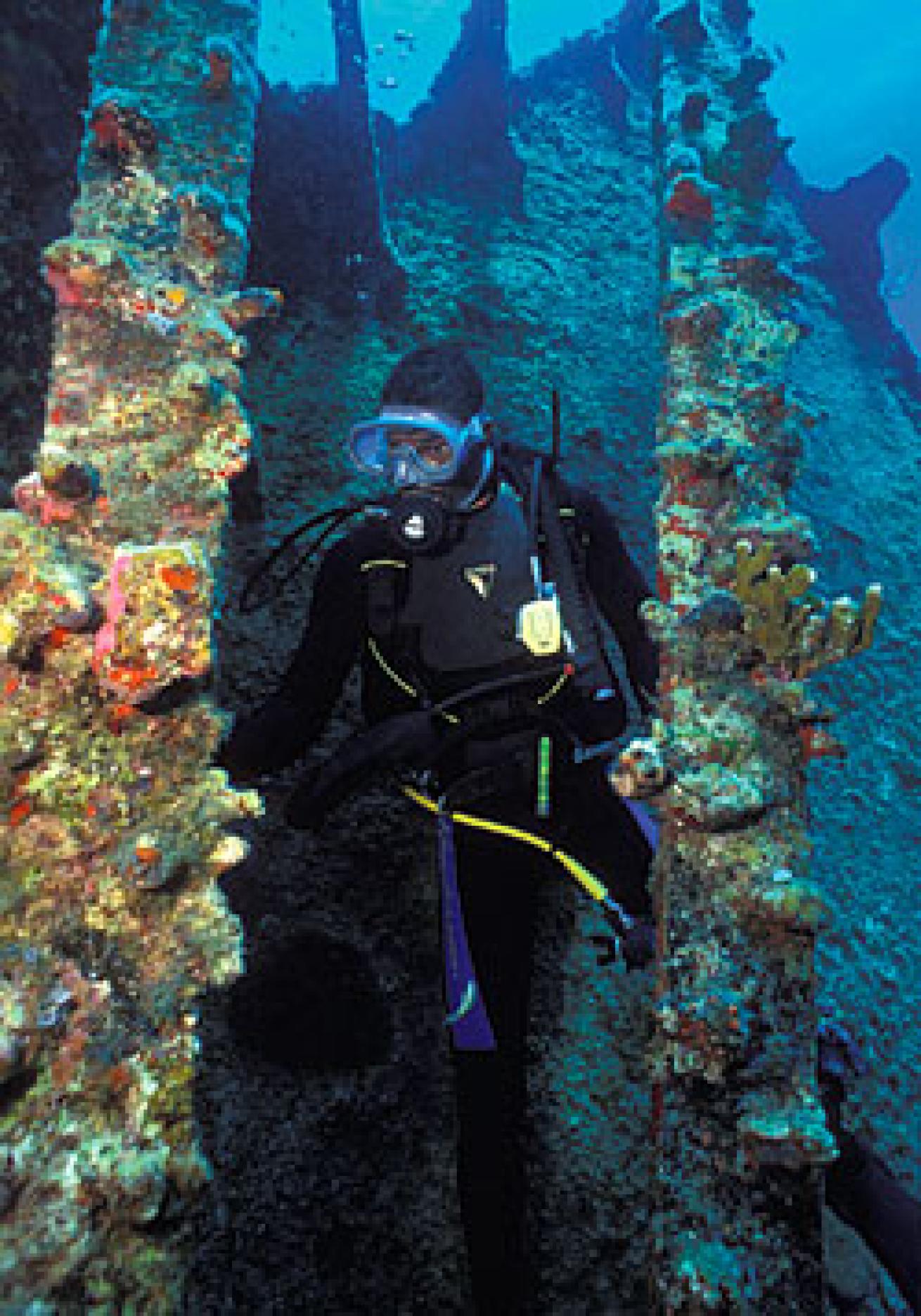
New Providence
New Providence is best known as home to Nassau, the capital city of the Bahamas, and for its wildly popular resort hotel, Atlantis. The island's long maritime heritage continues today: Where pirate ships once docked, cruise ships now moor. And while golf, shopping and other tourist activities are popular, most of the pleasures here remain tied to the underwater world. The best of the diving can be found away from Nassau, along the southwest end of the island.
Wrecks On the southwest side of the island are remnants of ships sunk as movie props for the James Bond thrillers Never Say Never Again and Thunderball. The photogenic Willaurie is a popular dive, as is a multi-wreck site called Steel Forest, but the most popular wreck is the Ray of Hope, a 200-foot freighter that is the site of frequent shark feeds.
Sharks Caribbean reef sharks are plentiful thanks to the nutrients washing off the Great Bahama Bank and the deep oceanic trench known as the Tongue of the Ocean. Clad in chainmail suits and helmets, the staff at Stuart Cove's Dive Bahamas use crates of bait to attract sharks within inches of visiting divers.
Walls The Tongue of the Ocean offers precipitous walls dotted with giant purple tube sponges. One of the most popular ways to tour these sites is "wall-flying"--cruising the drop-offs with the help of a diver propulsion vehicle.
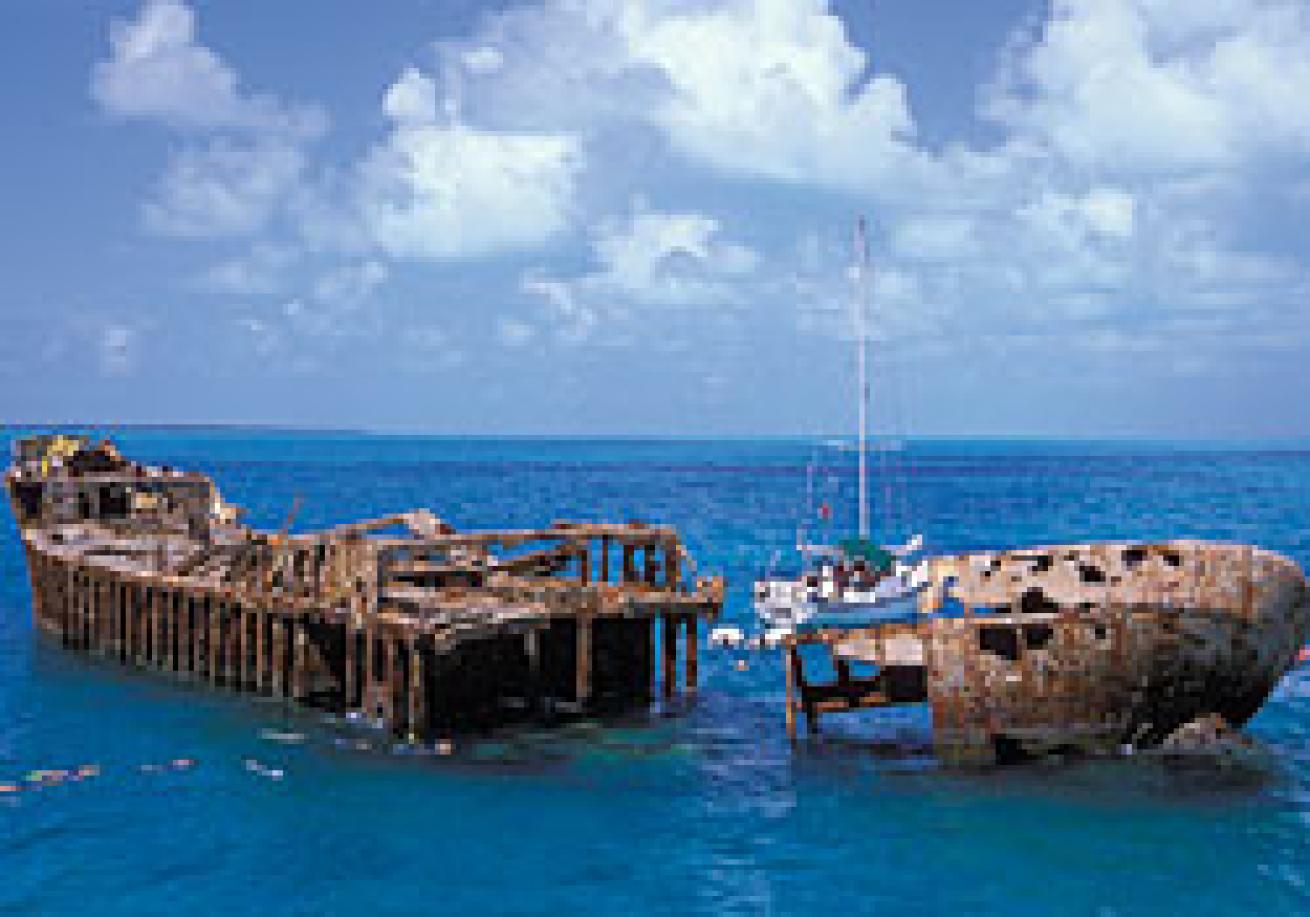
San Salvador
San Salvador may be best known as the purported site of Christopher Columbus's first landfall in the New World, but for a short while in the 1980s, the island was known for being the epicenter of recreational diving. This is when Skin Diver publisher Paul Tzimoulis ran photo classes here, and a lone dolphin named Sandy decided to take up residence for no apparent reason other than to swim with visiting divers. Those days are long gone, but San Salvador remains a significant dive destination, blessed with some of the clearest water I've ever seen in an ocean anywhere, amazing stretches of pristine white sand beach dotting the shoreline, and walls that start in 40 feet of water and boast rich corals, huge sponges and seasonal sightings of hammerheads.
Wrecks The Frascate was a 261-foot steamship, run aground under hurricane-force winds and now scattered in just 20 feet of water. The highlights are the massive boilers, with orifices large enough to swallow a diver or two.
Sharks There are no guarantees, but seasonal sightings of great hammerheads along the island's southwest end are possible.
Walls While the shallow reef is nice off San Sal, the walls are the big draw. The fact that they are vertical, begin in only 40 feet of water, and are washed by water with 100- to 150-foot clarity is a hard combination to beat. One standout site is Great Cut, a double drop where a huge section of the wall split away millennia ago. Once you drop into the cut, look for a swim-through tunnel at about 85 feet.
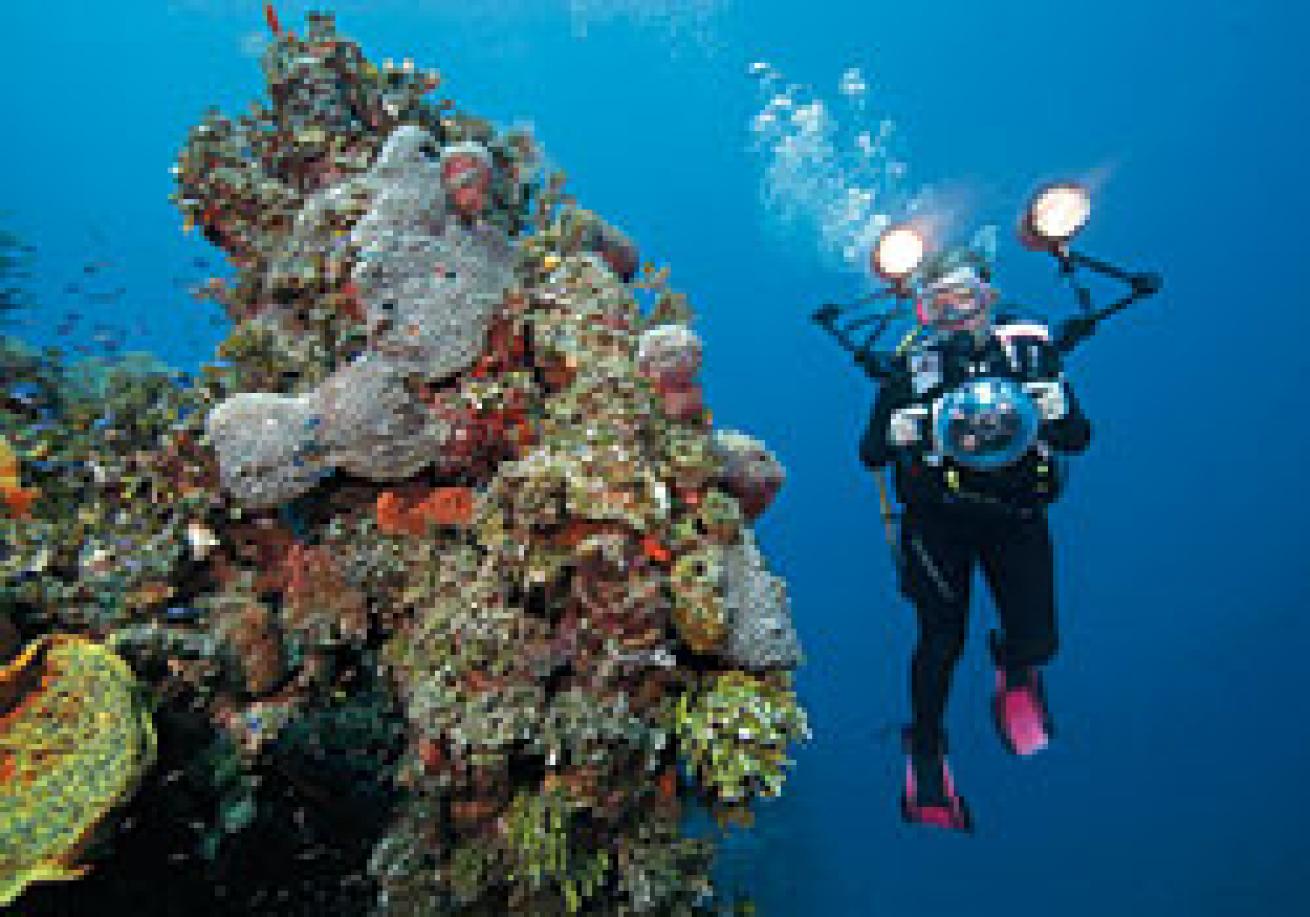
Bahamas Advertising Directory
Aqua Cat Cruises
888-327-9600
www.aquacatcruises.com
Coral Caverns Dive Resort
800-327-8150
www.coralcavernsresort.com
Explorer Ventures Live-Aboard Diving
800-322-3577
www.explorerventures.com
Nekton Diving Cruises
800-UW-WORLD
www.NektonCruises.com
Stella Maris Resort Club
800-426-0466
www.stellamarisresort.com
Stuart Cove's Dive Bahamas
800-879-9832
www.stuartcove.com
UNEXSO
800-992-DIVE
www.unexso.com
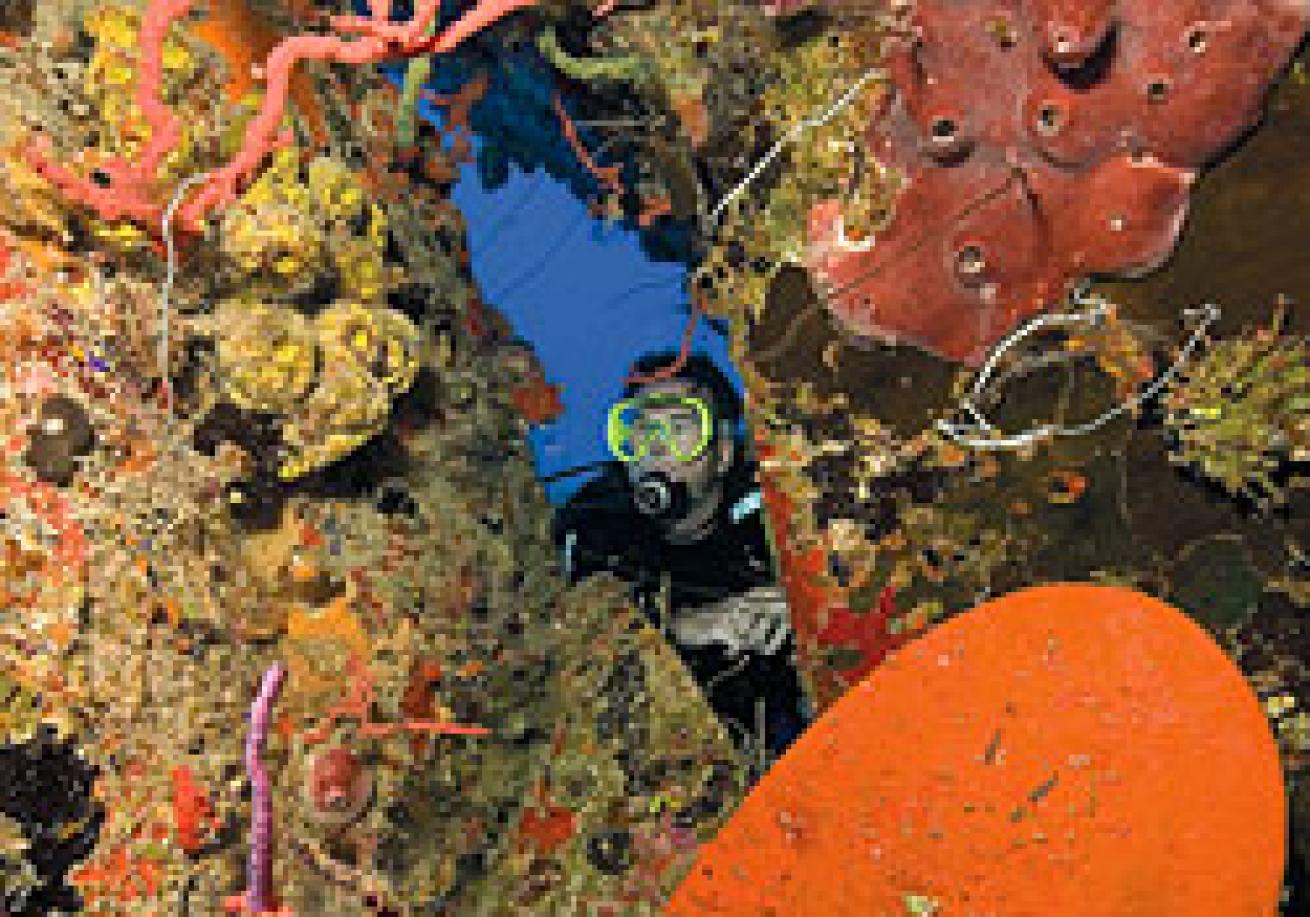
InDepth
Weather: In winter and early spring, temperatures range from 60 to 75 degrees, while summer temps are in the low to mid-80s.
Average Water Temp: Summer water temps peak in the high 80s; winter temps drop to the 70s.
Average Visibility: 80 to 100 feet.
Travel Savvy: A passport is required. Nonstop flight time from Miami (MIA) to Nassau/Paradise Island (NAS) and Freeport, Grand Bahama (FPO) is about 35 minutes. Nonstop flights are also available from other U.S. gateways, including Charlotte (CLT) and Philadelphia (PHL). Inter-island flights are readily available. Departure tax for Grand Bahama is $18; $15 for New Providence and the Out Islands.
Destination Links: www.scubadiving.com/bahamas, www.bahamas.com, www.bahama-out-islands.com, www.bahamasdiving.com.



